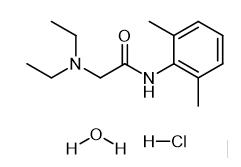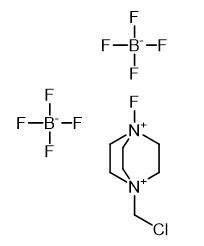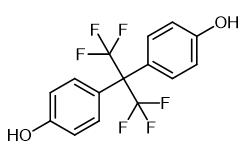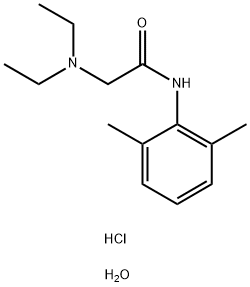Usage and Application of Linocaine hydrochloride
Aug 11,2022
General description
Lidocaine hydrochloride is a local anesthetic of amides. After blood absorption or intravenous administration, there are obvious excitatory and inhibitory biphasic effects on the central nervous system, and there can be no herald excitatory, low blood concentration, analgesia and narcolepsy pain threshold increased; With the increase of dose, the effect or toxicity is enhanced, and the subtoxic blood concentration has anticonvulsive effect.

Fig. 1 The structure of Linocaine hydrochloride.
Physicochemical property
Linocaine hydrochloride is white crystal, odorless taste slightly bitter and hemp. It is highly soluble in water, ethanol and organic solvents, but insoluble in diethyl ether. Linocaine hydrochloride aqueous solution does not decompose in acid-base condition, and it rarely deteriorates after repeated autoclaving.
Usage and dosage
2%~5% solution for topical anesthesia. For infiltration anesthesia, 0.25%~0.5% solution was used. For conduction anesthesia, 2% lidoca hydrochloride solution was used, 8 to 12 ml for horses and cattle, and 3 to 4 ml for sheep at each injection point. Epidural anesthesia 2% solution, 8~12 ml for cattle, 0.22 ml per kg body weight for dogs and cats. The maximum dosage of 2% solution for subcutaneous injection was 80 ml for pig and sheep, 400 ml for horse and cow, 25 ml for dog and 8.5 ml for cat. For the treatment of arrhythmias, intravenous administration: an initial dose of 2 to 4 mg per kilogram of body weight in dogs, followed by an intravenous infusion of 25 to 75 micrograms per minute, and an initial dose of 250 to 500 micrograms in cats, followed by an intravenous infusion of 20 micrograms per minute.
Drug interaction
(1) cimetidine β-receptor blocker can inhibit lidocaine metabolism through the liver, increase its blood concentration, can cause cardiac and nervous system adverse reactions, so the dose of lidocaine hydrochloride should be adjusted.
(2) Barbiturates can promote the metabolism of lidocaine hydrochloride, and the combination of the two drugs can cause bradycardia and sinus arrest.
(3) Combined with procaine amine, can produce transient delirium and hallucinations, but does not affect the blood concentration of this product.
(4) By increasing hepatic blood flow, isopropyl adrenalin can increase the total clearance rate of this product; Because norepinephrine reduces hepatic blood flow, the total clearance rate of lidocaine hydrochloride decreases.
(5) Contraindicated with phenobarbital, sodium thiopental, sodium nitroprusside, mannitol, amphotericin B, ampicillin, sulfadiazine.
Evaluation of their rheological and mechanical properties
Lidocaine hydrochloride is used as an anesthetic in many clinical applications. This short communication investigates the effect of complete substitution of lidocaine hydrochloride for deionized (DI) water on the physico-chemical properties of two novel glass polyalkenoate cements. Substituting DI water with lidocaine hydrochloride resulted in cements with shorter working times but comparable setting times and mechanical properties. Fourier transform infrared spectroscopy confirmed that the setting reaction in cements containing DI water and lidocaine hydrochloride was completed within 24 h, post cement preparation and maturation. Further, it was explained that lidocaine hydrochloride binds to poly(acrylic) acid (PAA) due to electrostatic forces between the positively charged amino group of lidocaine hydrochloride and the carboxylic group of the PAA, resulting in a compact poly-complex precipitate [1].
Detection Method
Two new spectrophotometric methods for the simultaneous determination of analgin and lidocaine hydrochloride in their binary mixture are described. In the first method, derivative spectrophotometry, dA/d lambda values were measured at 291.8 and 232.8 nm for analgin and lidocaine hydrochloride, respectively, in the first derivative spectra of their combination. The relative standard deviation of the method was found to be 0.23% for analgin and 1.19% for lidocaine hydrochloride. In the second method, extractive and first derivative spectrophotometry, analgin and lidocaine hydrochloride were extracted into chloroform in the presence of solid cobalt nitrate and potassium thiocyanate and the quantification of lidocaine hydrochloride was performed by reading the absorbency of the chloroform layer at 625.0 nm. The determination of analgin was carried out by measuring the dA/d lambda values at 290.0 nm in the first derivative spectra of the same layer. The relative standard deviation of the method was found to be 1.20 and 1.25% for analgin and lidocaine hydrochloride, respectively. These two methods have been successfully applied to an injection solution containing these drugs [2].
Two sensitive and selective analytical methods were developed for simultaneous determination of aminoacridine hydrochloride and lidocaine hydrochloride in bulk powder and pharmaceutical formulation. Method A was based on HPLC separation of the cited drugs with determination of the toxic lidocaine-related impurity 2,6-dimethylaniline. The separation was achieved using reversed-phase column C18, 250 x 4.6 mm, 5 mu m particle size and mobile phase consisting of 0.05 Mdisodium hydrogen phosphate dihydrate (pH 6.0 +/- 0.2 adjusted with phosphoric acid) and acetonitrile (55 : 45, v/v). Quantitation was achieved with UV detection at 240 nm. Linear calibration curve was in the range of 1.00-10.00, 13.20-132.00 and 1.32-13.20 mu g mL(-1) for aminoacridine hydrochloride, lidocaine hydrochloride and 2,6-dimethylaniline, respectively. Method B was based on TLC separation of the cited drugs followed by densitometric measurement at 365 nm on the fluorescent mode for aminoacridine hydrochloride and 220 nm on the absorption mode for lidocaine hydrochloride. The separation was carried out using ethyl acetate-methanol-acetic acid (65 : 30 : 5 by volume) as a developing system. The calibration curve was in the range of 25.00-250.00 ng spot(-1) and 0.99-9.90 mu g spot(-1) for aminoacridine hydrochloride and lidocaine hydrochloride, respectively. The results obtained were statistically analyzed and compared with those obtained by applying the manufacturer's method [3].
Application
Anesthesia
Simulated transportation of winter flounder, Pleuronectes americanus fingerlings was carried out to study the effects of lidocaine-hydrochloride on water parameters. Dissolved oxygen, ventilation rate, ammonia nitrogen and pH of control group, sham control group and lidocaine-hydrochloride treated groups of 5 ppm, 10 ppm, 20 ppm were tested at I h, 2 h, 3 h, 4 h and 5 h treatment duration. Lidocaine-hydrochloride treated groups, followed by sham control and control, were most effective in decreasing oxygen consumption and excretion of ammonia by fish. Lidocaine-hydrochloride dose-related decrease in oxygen consumption and excretion of ammonia were also established. pH declines in lidocaine-hydrochloride and sham control groups were more rapid compared to the control group. The results of this study reveal that lidocaine-hydrochloride is an effective sedative as a transportation mixture for winter flounder [4].
The effect on cyanobacteria
The metabolic effect of three different concentrations of lidocaine hydrochloride (0.01, 0.1, and 1 muM) on growth and saxitoxin (STX) production of the freshwater cyanobacterium Cylindrospermopsis raciborskii (Wolosznska) T3 was analyzed. Lidocaine hydrochloride increased both the growth rate and the final growth yield in the toxic cyanobacterium, with a maximum of 25% and 18% for a 1-muM dose, respecti
- Related articles
- Related Qustion
- Lidocaine hydrochloride: A local anesthetic Mar 19, 2025
Lidocaine hydrochloride is a local anesthetic that is used to numb an area of your body to help reduce pain or discomfort caused by invasive medical procedures.
- What is the difference between Lidocaine and Lidocaine Hydrochloride? Sep 9, 2024
Lidocaine Hydrochloride USP Monohydrate binds more readily to sodium channels in an activated state.
1-Chloromethyl-4-fluoro-1,4-diazoniabicyclo[2.2.2]octane bis(tetrafluoroborate) is an electrophilic fluorination reagent used for the green fluorination of acetacetam in PEG-400.....
Aug 10,2022APIHexafluorobisphenol A is mainly used as a vulcanization accelerator for fluororubber. The fluororubber vulcanized with FF34 has small permanent deformation and high tensile strength.....
Aug 11,2022APILidocaine hydrochloride
6108-05-0You may like
Lidocaine hydrochloride manufacturers
- Lidocaine hydrochloride
-

- $160.00/ kg
- 2025-12-13
- CAS:6108-05-0
- Min. Order: 1kg
- Purity: 99%pure
- Supply Ability: 20 tons
- Lidocaine hydrochloride
-

- $160.00 / 1kg
- 2025-12-13
- CAS:6108-05-0
- Min. Order: 1kg
- Purity: 99%pure
- Supply Ability: 20 tons
- Lidocaine hydrochloride
-

- $0.00 / 1G
- 2025-12-13
- CAS:6108-05-0
- Min. Order: 1G
- Purity: 99%
- Supply Ability: 1 ton/year






